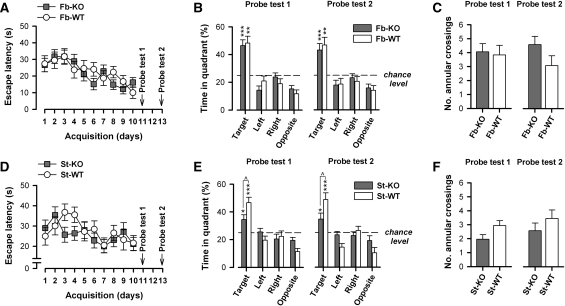Figure 5.
Reference memory performance is spared in fb-A2AR KO and st-A2AR KO mice. Mice were trained for 10 consecutive days (two trials per day) to acquire the fixed spatial location of a hidden escape platform. Following acquisition, two probe tests were conducted on days 11 (Probe test 1) and 13 (Probe test 2) during which the escape platform was removed from the pool and the spatial search pattern of mice was observed for 60 sec. (A) Fb-A2AR KO mice, like fb-WT mice, demonstrated a steady decline in escape latency with each training day, showing highly comparable escape performance by the end of acquisition training (day 10). (B) Both fb-A2AR KO and fb-WT mice showed a strong and similar search preference for the spatial location of the escape platform (i.e., target quadrant) in both probe tests. (C) Search accuracy defined by the number of annular crossings was comparable between fb-A2AR KO and fb-WT mice. (D) Similarly, st-A2AR KO and st-WT mice showed gradual performance improvement during acquisition, achieving near-identical performance at the end of training (day 10). (E) Both st-A2AR KO and st-WT mice demonstrated an above-chance level search preference for the target quadrant in both probe tests; however, this preference was weaker in st-A2AR KO mice. (F) St-A2AR KO and st-WT mice did not significantly differ in the number of annular crossings, indicating comparable search accuracy in both probe tests. Values depicted are mean ± SEM. *P < 0.05, **P < 0.01, ***P < 0.001 vs. chance level (=25%, dashed line). ∧P < 0.05, st-A2AR KO vs. st-WT.

